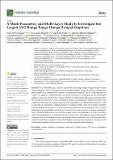Por favor, use este identificador para citar o enlazar a este item:
http://hdl.handle.net/10261/309778COMPARTIR / EXPORTAR:
 SHARE SHARE
 CORE
BASE CORE
BASE
|
|
| Visualizar otros formatos: MARC | Dublin Core | RDF | ORE | MODS | METS | DIDL | DATACITE | |

| Título: | A comprehensive multiparametric and multilayer approach to study the preparation phase of large earthquakes from ground to space: The case study of the June 15 2019, M7.2 Kermadec Islands (New Zealand) earthquake |
Autor: | De Santis, A.; Perrone, L.; Calcara, M.; Campuzano, S. A. CSIC ORCID; Cianchini, G.; D'Arcangelo, S.; Di Mauro, D.; Marchetti, D.; Nardi, A.; Orlando, M.; Piscini, A.; Sabbagh, D.; Soldani, M. | Palabras clave: | CSES | Earthquake | LAIC | Pre-earthquake anomalies | Swarm satellites | Fecha de publicación: | 29-jul-2022 | Citación: | Remote Sensing | Resumen: | This work deals with a comprehensive multiparametric and multilayer approach to study earthquake-related processes that occur during the preparation phase of a large earthquake. As a case study, the paper investigates the M7.2 Kermadec Islands (New Zealand) large earthquake that occurred on June 15, 2019 as the result of shallow reverse faulting within the Tonga-Kermadec subduction zone. The analyses focused on seismic (earthquake catalogs), atmospheric (climatological archives) and ionospheric data from ground to space (mainly satellite) in order to disclose the possible Lithosphere-Atmosphere-Ionosphere Coupling (LAIC). The ionospheric investigations analysed and compared the Global Navigation Satellite System (GNSS) receiver network with in-situ observations from space thanks to both the European Space Agency (ESA) Swarm constellation and the China National Space Administration (CNSA in partnership with Italian Space Agency, ASI) satellite dedicated to search for possible ionospheric disturbances before medium-large earthquakes, i.e. the China Seismo-Electromagnetic Satellite (CSES-01). An interesting comparison is made with another subsequent earthquake with comparable magnitude (M7.1) that occurred in Ridgecrest, California (USA) on 6 July of the same year but in a different tectonic context. Both earthquakes showed anomalies in several parameters (e.g. aerosol, skin temperature and some ionospheric quantities) that appeared at almost the same times before each earthquake occurrence, evidencing a chain of processes that collectively point to the moment of the corresponding mainshock. In both cases, it is demonstrated that a comprehensive multiparametric and multilayer analysis is fundamental to better understand the LAIC in the occasion of complex phenomena such as earthquakes. | Versión del editor: | 10.3390/rs14153649 | URI: | http://hdl.handle.net/10261/309778 | DOI: | 10.1016/j.rse.2022.113325 | ISSN: | 00344257 |
| Aparece en las colecciones: | (IGEO) Artículos |
Ficheros en este ítem:
| Fichero | Descripción | Tamaño | Formato | |
|---|---|---|---|---|
| remotesensing-14-03649-v2 (1).pdf | Articulo principal | 10,01 MB | Adobe PDF |  Visualizar/Abrir |
CORE Recommender
SCOPUSTM
Citations
16
checked on 23-abr-2024
WEB OF SCIENCETM
Citations
12
checked on 26-feb-2024
Page view(s)
28
checked on 30-abr-2024
Download(s)
22
checked on 30-abr-2024
Google ScholarTM
Check
Altmetric
Altmetric
Este item está licenciado bajo una Licencia Creative Commons

